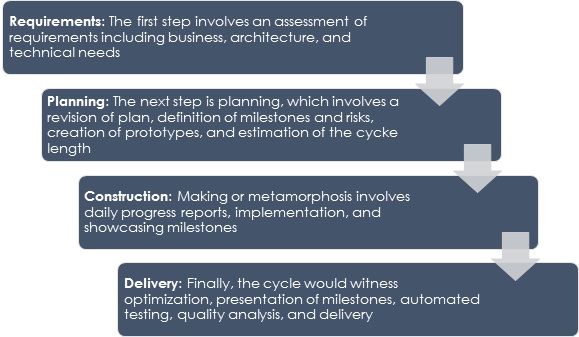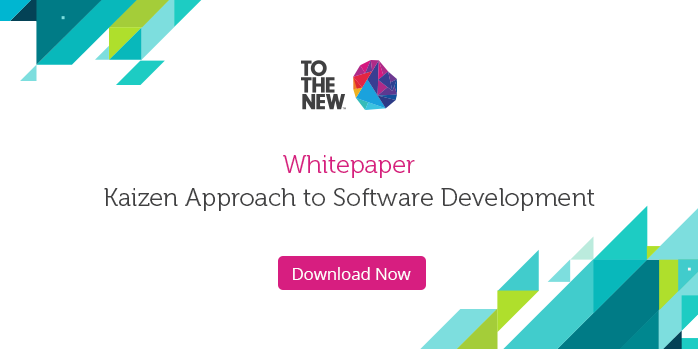The Kaizen Approach to Software Development
Recently, the technology industry has seen many developments and gone through several changes, especially owing to the advancements such as in the domains of artificial intelligence, augmented reality and others.
While many product development companies are more result oriented and focus heavily on the output, there is also a set of emerging enterprises that give equal importance to value creation practices within their organization.
The Kaizen approach is one such model used for software development and has actually originated from a philosophy which believes in overall development of people first. To put it simply, the Kaizen approach emphasizes on achieving continuous improvement by adding value to the organization and developing people.
The Model
Enterprises and startups both alike are changing the way products are built. Whether they are developing in-house or going for offshore software development services, they prefer using iterative Agile development so save time.
Along with Agile, companies are also increasingly adopting the Kaizen Model. The word Kaizen, in its literal sense, means ‘to improve’.
As per the Kaizen model, a popular approach which first originated in Japan, the organization is encouraged to set standards for the system, resulting in everybody working towards achieving it together.
In the process, the employees of the organization develop new skills and focus on learning more than delivering. However, this constructive approach results in preparing the employees for the long run, at the same time ensuring they meet their set goals.
While following the Kaizen practice, team members are asked to continually evaluate their work at every step which gives them a chance to step back and look for places where they could deliver better. They are also asked to run peer reviews, which helps them unite to work towards the same goal. In comparison to other models such as Waterfall, the Kaizen approach is much more collaborative and gives every individual a fair chance to shine in their domain, giving rise to smarter employees in the organization.
Advantages of the Kaizen Model:
Lowered Costs
Since the entire focus is on iterative software development, teams are encouraged to review their work every now and then, they tend to detect errors and shortcomings at the right time. As opposed to the traditional waterfall method, where errors are spotted almost towards the end of the development cycle, where the team is then made to work from scratch, all over again. In this process, a lot of time is saved, and so is the cost.
Enhanced Quality
Over the years, there has been a constant focus on improving the end user experience by building intuitive user interfaces and bug-free products. Regular peer reviews and work assessment make sure there are no errors in the development phase. Over the years, the practice of running peer reviews has given rise to a sense of competition amongst developers which used to be missing before. In earlier times, developers were more focused on just getting the product out, however, by adopting these innovative approached, developers have now started giving quality also its due importance. Another effective aspect of this practice if the accountability to peers, which has proven to work much better than the validation received from superiors.
Smarter Workforce
Regular assessments along with feedback lets the team members interact more often and share relevant knowledge. These small things help the developers learn new aspects to their regular job, which makes them smarter and open to innovation in general. Moreover, acquiring new skills helps employees feel more empowered and confident about the work they deliver.
Heightened Efficiency
The empowerment and added knowledge of their domains, helps employees perform better at their workplace. As discussed before, the Kaizen approach focuses on skill development of the employee, which in turn benefits in the form of better deliveries and higher ROI for the organizations. Hence, this is a win-win situation for both- the employee and the organization.
Effective Collaboration
Since under this approach, the entire team is involved in the overall decision making, reviewing of the WIP and making improvements to the code quality, each individual gets a chance to contribute in one way or another. Many would say that extensive collaboration could cause unwanted chaos and confusion, however, at the same time, different problems are met with novel solutions and tackled with new ideas and innovations.
The Kaizen Cycle
Whether considering outsourced product engineering services or in-house development, the Kaizen Cycle in software development entails the following steps:

Implementation of the Kaizen Model:
The Kaizen model can be integrated with the software development cycle in many ways. Here are a few prevalent methods that you can go through:
1. Day to Day vs Special Event
As per the day to day approach, a practice of calling meetings regularly to discuss opportunities for improvement are called. In these meetings, team members are asked to point out areas where they could have done better and enhanced the overall performance.
On following the Special Event approach, it takes longer to plan an improvement strategy and execute the same. The team is given a certain period of time to deliver the discussed improvements before they are reviewed and enhanced if required.
2. Individual vs Team
Another concept along the same lines, known as Teian, is brought to use here. As per Teian, the focus is more on individuals rather than the team. Each individual is asked to propose an improvement which is then taken forward for execution after deliberate discussions. Under this approach, one can also focus on personal Kaizen, to bring about improvements in their personal self.
While focusing on the Team, all team members are asked to discuss and figure out areas of improvement for everyone to work upon, together. Continuous improvement is the final goal that each team member works towards.
3. Process vs Sub Process
A process is generally referred to the entire software development lifecycle- right from scratch to the final delivery. Kaizen is not really implemented in the processes directly, rather, they are commonly implemented upon subprocesses.
A subprocess can be any component of a work process. While following the Kaizen approach, the developers are asked to propose improvements for all the small subprocesses that make up one component. Eventually, by working upon these processes, the ultimate goal of continuous improvement is successfully achieved and a better than the perfect product is delivered.
Conclusion
To sum up, Kaizen is a philosophy that focuses on delivering the best to the client. And this goal is impossible to achieve until and unless each member of the software development team contributes to the entire process. As a model, the Kaizen approach helps everyone benefit – in the form of developing new skills, achieving better results and delivering perfectly functioning products.
If enterprises in the west can successfully adopt this eastern concept, they can quickly improve their competence and deliver some really high-quality products. They would be benefited in the long run too, as the Kaizen approach helps build a culture of continuous learning, continuous integration and continuous deployment which has become absolutely necessary for today’s competitive world.
Take a deeper dive into the Kaizen model to understand it better, with our Whitepaper.


